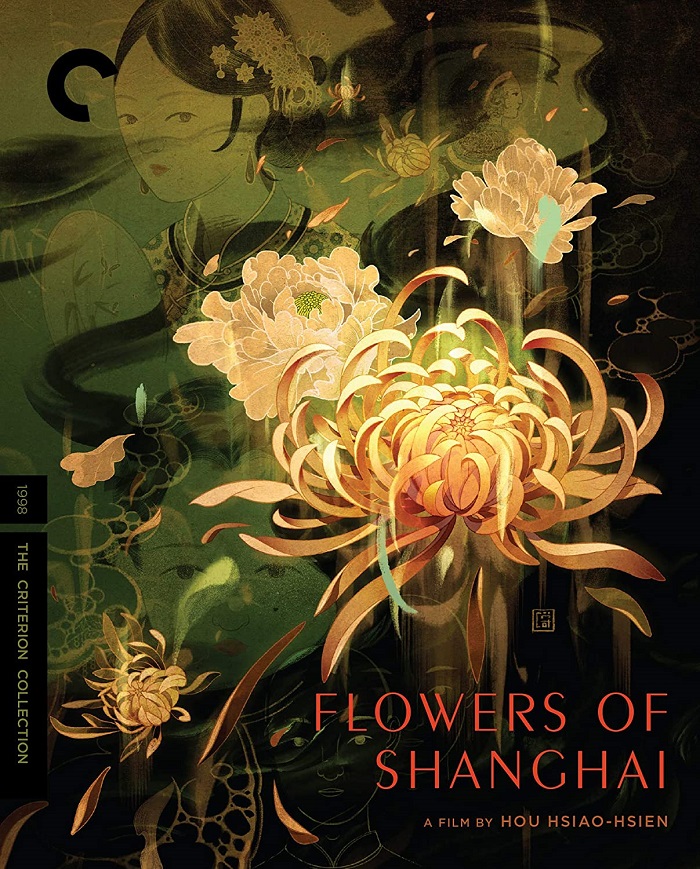
This Taiwanese movie was based on a novel about “flower houses” of 19th century Shanghai, high class establishments where courtesans could consort with wealthy recurring clientele. The flower girls lived full-time in the houses in something akin to indentured servitude, hoping to land a wealthy benefactor who might one day buy their release. In director Hou Hsiao-Hsien’s vision, the insular houses functioned as social gathering places for elite men of the city, with the men seemingly more interested in drinking, eating, gambling, and smoking a little opium than devoting their attention to the house girls.
Hou’s portrayal of the houses is so cloistered that it’s impossible to judge the era of the film’s setting, with its eventual reveal of late 19th century coming as a shock since the attire and interior décor could have been hundreds of years earlier, with the possible exception of references to “foreign currency” (from the British enclave of Shanghai) and the oil lanterns lighting the nighttime frivolity. That suffocating microcosm is partly by necessity, as Hou originally intended to shoot some exteriors in Shanghai but was denied by Chinese authorities, leading him to stage the entire production on soundstages in his native Taiwan.
While it’s somewhat difficult to get a handle on the story, it seemingly boils down to tracking the lives of three flower girls named Crimson, Emerald, and Pearl, as they try to better their situations as they circle the orbits of the powerful men visiting their houses. Crimson has reduced her client list to just one man, Master Wang (Tony Leung Chiu-wai), as she unsuccessfully attempts to coerce him into marrying her. Emerald is working on a much more likely exit plan, while Pearl seems content in continuing her veteran career.
Hou doesn’t make it easy to figure out what’s happening, structuring the film more like a documentary than a narrative feature. He opens with an eight-minute single shot scene that consists of men and women eating and drinking around a big table, with no explanation of who they are or who we should be watching. Leung is on screen from the start and yet doesn’t even utter a word until a full 15 minutes into the film, an inexcusable waste of his immense talent. Much of the film is party scenes, where at least the cast seems to be having fun even if they’re not moving the story anywhere (the included booklet reveals that they were actually drinking on set). There are no close-ups or establishing shots, just one floating single-camera mid shot after another, and although the camera is usually moving, it never leaves what would be a stage proscenium, resulting in some odd blocking choices that find us watching the back of actors’ heads at times.
Lead actor Tony Leung Chiu-wai (soon to be seen in Marvel’s Shang Chi) is saddled with a very subdued role here, giving him precious little to work with aside from flashes of grief as he tries to find an amicable solution for his situation. That leaves the best material for Hong Kong film star Michelle Ries as the veteran flower girl Emerald, cannily plotting to purchase her freedom as she shrewdly manipulates both her madam and her best customer. Fellow Hong Kong star Carina Lau doesn’t get much mileage out of her role as Pearl, another veteran flower girl. The third primary flower girl, Crimson, is played without much aplomb by Japanese actress Michiko Hada, with all of her lines clearly dubbed in spite of the production team’s efforts to match the syllables of her Japanese dialogue to its eventual Shanghainese dubbing.
The film has received a new 4K digital restoration from a 35mm film negative for this release, along with a new 5.1 surround DTS-HD Master Audio soundtrack created from digital master audio files. Image quality is almost free of defects, with just one momentary blotch on the picture noted during my viewing. The cinematography was designed to showcase the warm lighting cast by oil lamps in the flower houses, resulting in a fairly limited color palette primarily running between red and yellow. Sound quality is pristine, although the small interior sets of the project don’t really lend themselves to much benefit from the 5.1 surround mix.
Bonus features include an informative introduction by a film critic who provides some background on the history and culture of the flower houses, especially helpful in the absence of any exposition within Hou’s film. The disc also includes an enlightening new documentary about the film entitled Beautiful Realism that incorporates behind-the-scenes footage with crew interviews. Excerpts from a 2015 interview with Hou are included, where he proves to be a less than animated interview subject but methodically shares some insight into his process for this film. The booklet included with the film has the text of another lengthy interview with Hou from 2009, along with an essay by a film scholar.
Regrettably, the film is difficult to recommend. It’s pretty enough to look at, and it’s fun to see Hong Kong film legends Leung, Ries, and Lau in a Taiwanese project together, but the pacing is so glacial and the settings and character backstories are so poorly defined that it’s hard to care about the eventual outcome. Criterion is to be commended for giving this new restoration a full-featured U.S. Blu-ray release, but much like the flower houses, the film is just superficial window dressing without much meaningful substance.